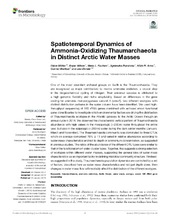| dc.contributor.author | Müller, Oliver | |
| dc.contributor.author | Wilson, Bryan | |
| dc.contributor.author | Paulsen, Maria Lund | |
| dc.contributor.author | Rumińska, Agnieszka | |
| dc.contributor.author | Armo, Hilde R. | |
| dc.contributor.author | Bratbak, Gunnar | |
| dc.contributor.author | Øverås, Lise | |
| dc.date.accessioned | 2018-09-20T12:45:34Z | |
| dc.date.available | 2018-09-20T12:45:34Z | |
| dc.date.issued | 2018-01-23 | |
| dc.identifier.issn | 1664-302X | en_US |
| dc.identifier.uri | https://hdl.handle.net/1956/18529 | |
| dc.description.abstract | One of the most abundant archaeal groups on Earth is the Thaumarchaeota. They are recognized as major contributors to marine ammonia oxidation, a crucial step in the biogeochemical cycling of nitrogen. Their universal success is attributed to a high genomic flexibility and niche adaptability. Based on differences in the gene coding for ammonia monooxygenase subunit A (amoA), two different ecotypes with distinct distribution patterns in the water column have been identified. We used high-throughput sequencing of 16S rRNA genes combined with archaeal amoA functional gene clone libraries to investigate which environmental factors are driving the distribution of Thaumarchaeota ecotypes in the Atlantic gateway to the Arctic Ocean through an annual cycle in 2014. We observed the characteristic vertical pattern of Thaumarchaeota abundance with high values in the mesopelagic (>200 m) water throughout the entire year, but also in the epipelagic (<200 m) water during the dark winter months (January, March and November). The Thaumarchaeota community was dominated by three OTUs which on average comprised 76% ± 11 and varied in relative abundance according to water mass characteristics and not to depth or ammonium concentration, as suggested in previous studies. The ratios of the abundance of the different OTU types were similar to that of the functional amoA water cluster types. Together, this suggests a strong selection of ecotypes within different water masses, supporting the general idea of water mass characteristics as an important factor in defining microbial community structure. If indeed, as suggested in this study, Thaumarchaeota population dynamics are controlled by a set of factors, described here as water mass characteristics and not just depth alone, then changes in water mass flow will inevitably affect the distribution of the different ecotypes. | en_US |
| dc.language.iso | eng | eng |
| dc.publisher | Frontiers | en_US |
| dc.relation.ispartof | <a href="http://hdl.handle.net/1956/18525" target="blank">Implications of a changing Arctic on microbial communities: Following the effects of thawing permafrost from land to sea</a> | en_US |
| dc.rights | Attribution 4.0 International (CC BY 4.0) | eng |
| dc.rights.uri | https://creativecommons.org/licenses/by/4.0/ | eng |
| dc.title | Spatiotemporal Dynamics of Ammonia-Oxidizing Thaumarchaeota in Distinct Arctic Water Masses | en_US |
| dc.type | Peer reviewed | |
| dc.type | Journal article | |
| dc.description.version | publishedVersion | en_US |
| dc.rights.holder | Copyright the Author(s) | en_US |
| dc.source.articlenumber | 24 | |
| dc.identifier.doi | https://doi.org/10.3389/fmicb.2018.00024 | |
| dc.source.journal | Frontiers in Microbiology | |
| dc.source.40 | 9 | |
| dc.subject.nsi | VDP::Matematikk og Naturvitenskap: 400::Zoologiske og botaniske fag: 480::Marinbiologi: 497 | en_US |

